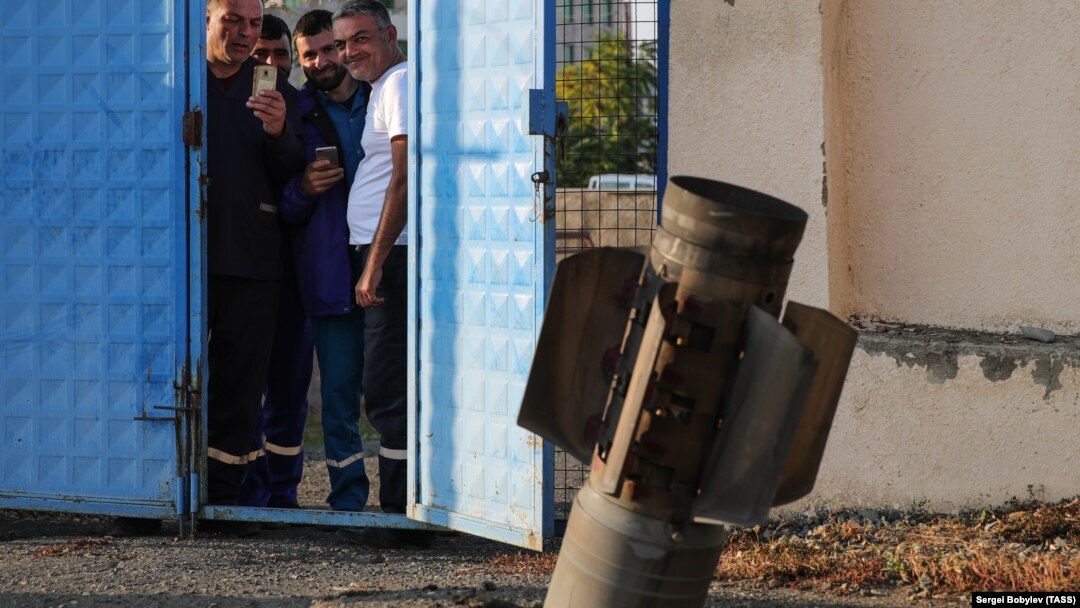The capital of Azerbaijan's breakaway region of Nagorno-Karabakh came under artillery fire on October 15 after a shaky pause in shelling brought on by a five-day-old cease-fire brokered by Russia, according to Yerevan and ethnic Armenian separatists in the province.
The renewed attacks on Stepanakert further erode hopes for an early break in the heavy fighting that flared up two weeks ago.
There are fears that the decades-old Caucasus conflict between Azerbaijan and Armenia over the mountainous Nagorno-Karabakh region could spread into a wider conflagration involving allies Turkey and Russia.
“Five days into the Moscow Joint Statement of October 10 on cessation of fire, and Azerbaijan continues to torpedo its implementation,” Armenian Foreign Minister Zohrab Mnatsakanian tweeted.
Your browser doesn’t support HTML5
A Truce In Tatters: Fighting Flares Over Nagorno-Karabakh
Armenia's Defense Ministry said Azerbaijani forces in the morning had resumed “intense artillery fire” targeting sections of the Line of Contact that has separated the Azerbaijani and ethnic Armenian sides in northeastern and southeastern Karabakh.
"Heavy fighting is now under way at the same sections,” a ministry spokesman wrote on Facebook.
Meanwhile, the emergency services arm of the de facto leadership of Nagorno-Karabakh wrote on Facebook that Azerbaijani forces had struck "civilian targets" in Stepanakert.
An AFP journalist there reported hearing nine blasts and said smoke could be seen rising near residential buildings on the outskirts of the city, which normally has around 55,000 of Nagorno-Karabakh's 150,000 or so residents.
Stepanakert has been bombed repeatedly since fighting between Azerbaijani and Armenian forces erupted late last month in clashes that have claimed hundreds of lives, including civilians.
The ethnic Armenian authorities who have controlled Nagorno-Karabakh for decades with Yerevan's backing said on October 14 that their forces had lost 555 fighters.
The situation in Stepanakert had been calm since the longstanding ex-Soviet rivals agreed to halt fighting last week to exchange prisoners and the remains of those killed in the fighting.
Your browser doesn’t support HTML5
'No War Is Winnable': Obstacles To Peace Over Nagorno-Karabakh
Armenia on October 15 accused Turkey of blocking flights carrying emergency aid from using its airspace, as the fresh fighting threatened to pitch the region into a humanitarian crisis.
Regional power Turkey is Azerbaijan's main ally, and has been accused by Armenia of backing Baku with military equipment and fighters.
Armenian Prime Minister Nikol Pashinian acknowledged on October 14 that separatist fighters had been forced to withdraw from positions in the north and south, describing the situation as "very serious."
Nagorno-Karabakh is internationally recognized as part of Azerbaijan, but is mostly populated by ethnic Armenians.
Azerbaijan's president, Ilham Aliyev, said on October 15 that he believed the conflict might finally be solved after almost 30 years of talks, but warned that his army would take all regions around the enclave if Armenia continued to "act negatively."
Speaking to Turkish broadcaster NTV, Aliyev said his military already controlled two of Nagorno-Karabakh's five major regions and that they would take them all unless Yerevan agreed to withdraw from the area under a specific timeline.


